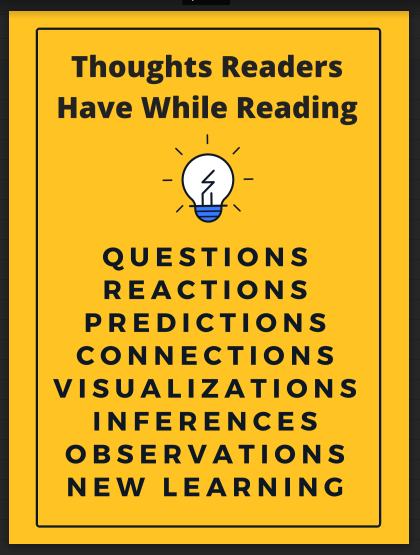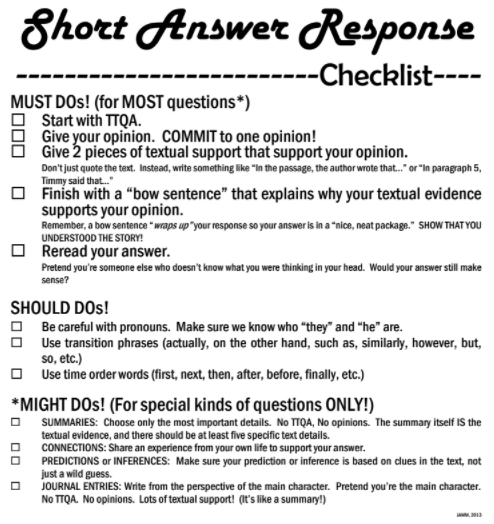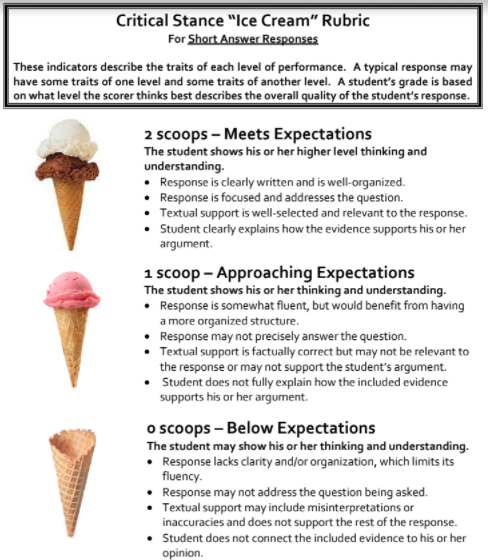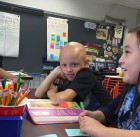Viewing: rubric
October 24, 2019
Starting Science, Short Answer Responses, and more!
Someone asked me last week what my favorite subject to teach was. I’ve been asked that numerous times, and I think it’s one of the hardest things to answer. I love teaching reading, because books allow us to take a (metaphorical) field trip to new places, new times, and new situations, and to talk about each one. I love talking about what we read! I love teaching math, because it’s fascinating to see how skills can build on one another, and that’s where I tend to see kids have those “lightbulb” a-ha moments most often. Science is a real passion of mine, and I absolutely love seeing kids draw their own conclusions in class. (I’m also biased, because I wrote three of our four science units in fourth grade, so I know the lessons well and feel a sense of pride.) It’s at this point that I realize that I’ve given a snub to writing and social studies, and I quickly scamper to explain that I love those too, and I end up just saying that I love teaching everything. Perhaps it changes from day to day – and today, it was all about science!
The kids are SO excited to share their science projects with the class, which I was thrilled to see. We only got through two projects today, and the kids know that it will take several days to have everyone share. Today’s creative presentations taught us about the scientific properties of apples and apple trees, as well as about the effervescent qualities of Polident tabs. We continued the science theme of the day and kicked off our first science unit, which is all about energy. Today, we learned about electrical energy and how static electricity flows from negative to positive. We teamed up with Mrs. Matos’s class, which we’ll do from time to time throughout the year.
We’ve kicked off our first science unit today with Mrs. Matos’s class! We’re learning about energy, and today, we started by learning how electricity flows in a circuit. #AskYourKid why we couldn’t take a wire and put a light at one end and a battery at the other. More tomorrow! pic.twitter.com/bEMuthNzXs
— Jon Moss (@MossTeaches) October 24, 2019

That’s not all, however! In reading, we’ve learned about the eight kinds of thoughts readers have while reading. I encourage kids to be aware of when these thoughts pop into their head, because these are what allow us to have rich discussions about what we read. These will be critical for when we launch book clubs in the late fall or winter.
We’ve moved on, in reading, to beginning our study of narrative elements. We’re going slowly (right now), because this is also our launch into short answer responses (SAR). Kids have been doing this for years, and each year, the expectations mature a bit. We drafted a SAR about the setting of the WONDERFUL book The Purple Coat, and students are working with partners to identify and explain the setting of the book The Josefina Story Quilt.

This week, we looked at the SAR checklist, which helps the students to learn what goes into a quality short answer response. TTQA stands for “Turn the Question Around”. A bow sentence shows how the textual evidence connects to the reader’s opinion. For example, if I wrote “Miss Viola Swamp was a talented teacher. I know this because she was very strict and yelled at the kids.” you might wonder why her yelling supported the idea that she was a good teacher. (Nowadays, we tend to frown on teachers who yell too much!) But if I added the sentence “The class was really wild, and she was the only person who could get them calmed down and working hard to learn.” you might better see the connection. That’s what a Bow Sentence does. The rest of these are probably more clear to you. We’ll be using this document a lot this year, and I’ll be sending home copies soon.

The Ice Cream Rubric doesn’t rate any ice cream cones. Instead, it focuses on how we assess a student’s short answer response. In class, we talked about this rubric’s value as more than something that helps to yield a grade. It helps students to know what a strong response looks like and helps them to evaluate their own work. Again, I have copies of this which will be sent home in the coming weeks.
In math, we’ve finished the first unit (as you know), and the math assessments will come home early next week. (I’d like you to sign and return them, and since I want to give you a few days to do that, I didn’t want to go over the weekend.) Right now, students are doing a great job learning about factors and multiples.
We’ve started learning about map skills, focusing on cardinal directions, latitude, and longitude. My class last year was kind enough to purchase us a dry erase globe, which has been a GREAT resource for introducing these skills.
More to come! As always, feel free to contact me with any questions.
Posted in Class Updates|By Jon Moss
November 14, 2018
How Written Responses Are Evaluated
With report cards going live this morning and parent conferences kicking off tomorrow afternoon, I wanted to take a moment to encourage you to visit your child’s Google Classroom page. You’ll need to login with his or her username and password, but the students know that she should always be willing to share their login information with their parents/guardians. On our Google Classroom page, you’ll find much of your child’s written work, including responses to text (check out “A Chair for My Mother SAR”) and descriptive writing (look for the “Summer Snapshot” writing) projects. Feel free to look around, but PLEASE allow your child to do his or her work at school, and please resist the strong urge (Hey, I get it!) to help your child to improve the works-in-progress you see (since I won’t know what’s your child’s work and what is your work).
While not all the documents you’ll come across are intended to be graded (as some are planning tools for other purposes, others are collaborative practice, etc.), those tasks that are assessed are graded within the document itself. All grades and comments from me are written in yellow text, highlighted in black. Bold as that is, it clearly distinguishes my work from your child’s work. (Think of that color pattern as my trademark “teacher’s red pen”, if you will.)
 Short answer responses are most typically assessed on a 0-1-2 point scale. Here is a copy of the rubric we use. I want to stress that 0, 1, and 2 should not be converted into a percentage. That is, I’d hate for you to think a score of 1/2 is the same as 50% (a failing grade) or that 2/2 is 100% (perfection). Rather, a 2/2 is a proficient response that includes all the elements I am looking to see. Could it potentially be improved? Of course! A 2/2 doesn’t mean that it’s perfect, just that it met expectations. Likewise, a 1/2 isn’t a failing grade. It means that the student is well on his or her way to developing a successful response, but he or she needs to improve one or more parts of the response in order to reach a 2. When I give a 1, I find myself most often asking students to give more textual support, to select more appropriate textual support, or to focus their response on a single idea and develop that idea more thoroughly. You’ll always see comments from me to explain why your child received the score he or she did.
Short answer responses are most typically assessed on a 0-1-2 point scale. Here is a copy of the rubric we use. I want to stress that 0, 1, and 2 should not be converted into a percentage. That is, I’d hate for you to think a score of 1/2 is the same as 50% (a failing grade) or that 2/2 is 100% (perfection). Rather, a 2/2 is a proficient response that includes all the elements I am looking to see. Could it potentially be improved? Of course! A 2/2 doesn’t mean that it’s perfect, just that it met expectations. Likewise, a 1/2 isn’t a failing grade. It means that the student is well on his or her way to developing a successful response, but he or she needs to improve one or more parts of the response in order to reach a 2. When I give a 1, I find myself most often asking students to give more textual support, to select more appropriate textual support, or to focus their response on a single idea and develop that idea more thoroughly. You’ll always see comments from me to explain why your child received the score he or she did.
How does your child know what goes into a 2/2 response? Good question! In our class, we use a short answer response (SAR) checklist to help students know what a thorough response looks like. Pictured to the right, this checklist lets students organize their writing. Your child should be able to explain to you what things like TTQA and “bow sentences” are.
Other areas, such as organization, sentence structure, grammar, capitalization and punctuation, and spelling are assessed using our report card scale: EMAB. A score of M is most common, indicating that a student is meeting grade-level expectations. An E means that a student has exceeded my grade level expectations. It’s important for you to understand that I don’t look at an M as falling short of earning an E, even though many families tend to feel this way. When a student’s work goes above and beyond and shows a particularly sophisticated application of the concept or skill, he or she may earn an E. Parents often ask “What does my child need to do to earn an E?” That’s really hard to answer. Allow me to provide an example. Imagine a student wrote the following description of our classroom:
There are homemade posters, called anchor charts, hanging all over from lessons. They help us to remember what Mr. Moss taught us. There are also book boxes that alternate in color between yellow and green. These hold all the great books that we get from our class library, school library, or from home. The colorful paper lanterns add even more color to our classroom.
That was a perfectly good description of our classroom, and if I was assessing the response’s sentence structure, it would earn an M. Now compare it to this response:
In our classroom, homemade posters hang all over. Called anchor charts, these tools help us to remember what Mr. Moss has taught us. The yellow and green book boxes add a splash of color to the room, as do the hanging colorful paper lanterns.
It’s clear that this second passage is a more sophisticated style of writing, and it’s sentence structure grade would be an E. But if a parent were to ask me what their student (writer of the first response) needs to do to improve, I’d have a hard time explaining it. The growth comes naturally, as a student becomes a more mature writer. As their overall use of the written English language matures, so will these discrete sentences. It’s the same with word choice. I’d hate for a parent of a student earning an M for word choice to have their child study new vocabulary words with the specific goal of earning a better grade. Instead, as the child reads more mature books with more mature word choices, it’s reasonable to expect that their lexicon will continue to grow and develop.
A grade of A means that a child is approaching the goal, is continuing to work to develop his or her skills in a given area, and has more work to do before reaching goal. An A isn’t a disaster. While I do want to avoid seeing too many A’s in a student’s work, it can serve as a focus area for your child (and perhaps for you, as you work to support your child). Finally a B means that your child’s work is below expectations and that he or she has plenty of room to grow.
I look forward to answering any of your questions about this when we meet for parent-teacher conferences. But in anticipation of our upcoming conversation, please take a moment to look at your child’s Google Classroom page so you are best informed of his or her progress in class.
Posted in Class Updates|By Jon Moss
November 9, 2017
How Written Responses are Assessed
With report cards coming home in about a week, I wanted to take a moment to encourage you to visit your child’s Google Classroom page. You’ll need to login with his or her username and password, but the students know that she should always be willing to share their login information with their parents/guardians. On our Google Classroom page, you’ll find much of your child’s written work, including responses to text (check out “A Chair for My Mother SAR”) and descriptive writing (look for the “Summer Snapshot” writing) projects. Feel free to look around, but PLEASE allow your child to do his or her work at school, and please resist the strong urge (Hey, I get it!) to help your child to improve the works-in-progress you see (since I won’t know what’s your child’s work and what is your work).
While not all the documents you’ll come across are intended to be graded (as some are planning tools for other purposes, others are collaborative practice, etc.), those tasks that are assessed are graded within the document itself. Any grades and comments are written in yellow text, highlighted in black. Bold as that is, it clearly distinguishes my work from your child’s work. (Think of that color pattern as my trademark “teacher’s red pen”, if you will.)
 Short answer responses are most typically assessed on a 0-1-2 point scale. Here is a copy of the rubric we use. I want to stress that 0, 1, and 2 should not be converted into a percentage. That is, I’d hate for you to think a score of 1/2 is the same as 50% (a failing grade) or that 2/2 is 100% (perfection). Rather, a 2/2 is a proficient response that includes all the elements I am looking to see. Could it potentially be improved? Of course! A 2/2 doesn’t mean that it’s perfect, just that it met expectations. Likewise, a 1/2 isn’t a failing grade. It means that the student is well on his or her way to developing a successful response, but he or she needs to improve one or more parts of the response in order to reach a 2. When I give a 1, I find myself most often asking students to give more textual support, to select more appropriate textual support, or to focus their response on a single idea and develop that idea more thoroughly. You’ll always see comments from me to explain why your child received the score he or she did.
Short answer responses are most typically assessed on a 0-1-2 point scale. Here is a copy of the rubric we use. I want to stress that 0, 1, and 2 should not be converted into a percentage. That is, I’d hate for you to think a score of 1/2 is the same as 50% (a failing grade) or that 2/2 is 100% (perfection). Rather, a 2/2 is a proficient response that includes all the elements I am looking to see. Could it potentially be improved? Of course! A 2/2 doesn’t mean that it’s perfect, just that it met expectations. Likewise, a 1/2 isn’t a failing grade. It means that the student is well on his or her way to developing a successful response, but he or she needs to improve one or more parts of the response in order to reach a 2. When I give a 1, I find myself most often asking students to give more textual support, to select more appropriate textual support, or to focus their response on a single idea and develop that idea more thoroughly. You’ll always see comments from me to explain why your child received the score he or she did.
How does your child know what goes into a 2/2 response? Good question! In our class, we use a short answer response (SAR) checklist to help students know what a thorough response looks like. Pictured to the right, this checklist lets students organize their writing. Your child should be able to explain to you what things like TTQA and “bow sentences” are.
Other areas, such as organization, sentence structure, grammar, capitalization and punctuation, and spelling are assessed using our report card scale: EMAB. A score of M is most common, indicating that a student is meeting grade-level expectations. An E means that a student has exceeded my grade level expectations. It’s important for you to understand that I don’t look at an M as falling short of earning an E, even though many families tend to feel this way. When a student’s work goes above and beyond and shows a particularly sophisticated application of the concept or skill, he or she may earn an E. Parents often ask “What does my child need to do to earn an E?” That’s really hard to answer. Allow me to provide an example. Imagine a student wrote the following description of our classroom:
There are homemade posters, called anchor charts, hanging all over from lessons. They help us to remember what Mr. Moss taught us. There are also book boxes that alternate in color between yellow and green. These hold all the great books that we get from our class library, school library, or from home. The colorful paper lanterns add even more color to our classroom.
That was a perfectly good description of our classroom, and if I was assessing the response’s sentence structure, it would earn an M. Now compare it to this response:
In our classroom, homemade posters hang all over. Called anchor charts, these tools help us to remember what Mr. Moss has taught us. The yellow and green book boxes add a splash of color to the room, as do the hanging colorful paper lanterns.
It’s clear that this second passage is a more sophisticated style of writing, and it’s sentence structure grade would be an E. But if a parent were to ask me what their student (writer of the first response) needs to do to improve, I’d have a hard time explaining it. The growth comes naturally, as a student becomes a more mature writer. As their overall use of the written English language matures, so will these discrete sentences. It’s the same with word choice. I’d hate for a parent of a student earning an M for word choice to have their child study new vocabulary words with the specific goal of earning a better grade. Instead, as the child reads more mature books with more mature word choices, it’s reasonable to expect that their lexicon will continue to grow and develop.
A grade of A means that a child is approaching the goal, is continuing to work to develop his or her skills in a given area, and has more work to do before reaching goal. An A isn’t a disaster. While I do want to avoid seeing too many A’s in a student’s work, it can serve as a focus area for your child (and perhaps for you, as you work to support your child). Finally a B means that your child’s work is below expectations and that he or she has plenty of room to grow.
I look forward to answering any of your questions about this when we meet for parent-teacher conferences. But in anticipation of our upcoming conversation, please take a moment to look at your child’s Google Classroom page so you are best informed of his or her progress in class.
Posted in Class Updates|By Jon Moss
October 4, 2015

Learning to Collaborate
A big focus in Room 209 in learning to collaborate on tasks and explain your thinking. People often think that collaboration helps during challenging activities, and that’s certainly true. But we also have students collaborate even when they could easily complete a task independently, because the process of sharing ideas, considering other points of view, and discussing strategies and options helps students to think more deeply about a given topic. It also helps to develop collaboration skills that are, of course, critical life skills.
Last week, for example, we began working on narrative elements by focusing on the setting of stories. We read, as a class, The Purple Coat (one of my all-time favorites) and identified clues about the setting. I then modeled the process of writing a short-answer response (SAR) to identify and explain the setting of the story. We looked at the SAR Checklist as a way of remembering the elements of a successful short-answer response. Students then collaborated with one or two partners to write a similar response about The Josefina Story Quilt, which students read for homework on Monday or Tuesday. We shared some of these responses (from groups that volunteered) and discussed strengths and weaknesses, using the new fourth grade SAR rubric. (Stay tuned for some resources for parents!) On Friday, students worked independently to write their own SAR about the setting of A Chair for My Mother (which is arguably my all-time favorite children’s book). This process of gradual release supports students as we move from teacher-led learning to group work to independent application. You’ll see a lot of this style of learning this year, especially in the next few weeks as we address the remaining narrative elements.
Posted in Class Updates|By Jon Moss
